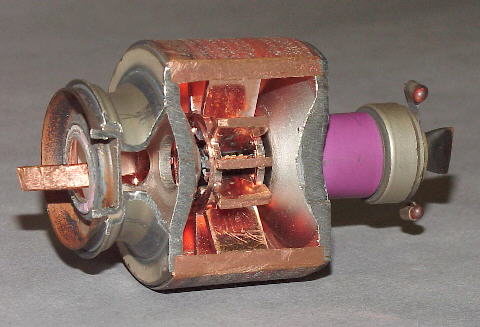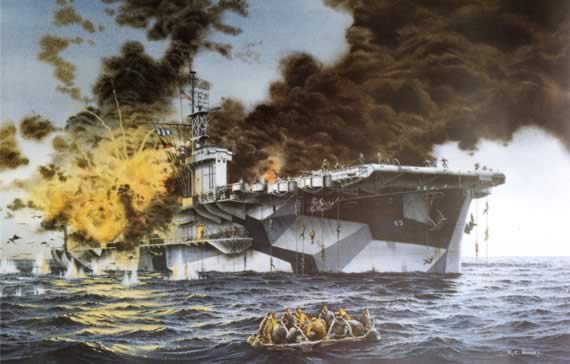Project CADILLAC: AEW and the US Navy (Part One)
Project CADILLAC (Part I)
 Ed note: Everything has a beginning and that beginning is usually quite humble compared to present conditions. Consider, a small spring at the headwaters of the Madison River in Montana is the source of the mighty Missouri River which itself empties into ol’ man river — the Mississippi, all of which drain the better part of the country described in the Louisiana Purchase. Likewise, current day Airborne Early Warning and battle management, as we know it, sprang from humble beginnings and the collaborative efforts of the private and public sectors and born in the urgency of war. Herewith then, the story of that effort is told as we begin the observance of the Hawkeye’s 50th Anniversary of service to the Fleet. – SJS
Ed note: Everything has a beginning and that beginning is usually quite humble compared to present conditions. Consider, a small spring at the headwaters of the Madison River in Montana is the source of the mighty Missouri River which itself empties into ol’ man river — the Mississippi, all of which drain the better part of the country described in the Louisiana Purchase. Likewise, current day Airborne Early Warning and battle management, as we know it, sprang from humble beginnings and the collaborative efforts of the private and public sectors and born in the urgency of war. Herewith then, the story of that effort is told as we begin the observance of the Hawkeye’s 50th Anniversary of service to the Fleet. – SJS
There is an arrogance permeating our culture such that it is widely believed that the (fill in the blank with the latest technological wonder) is (1) fairly recent in invention and (2) anything that preceded was hopelessly crude and unsophisticated, if it even existed or could have been possibly conceived in an earlier age. Serious students of history, particularly technological history, will assert though, the degree of inventiveness and technical complexity shown by our predecessors is extraordinary, especially when considering the body of knowledge in a particular field at the time. The story of airborne radar, and airborne early warning radar in particular, is one of the signatory lessons in this vein.

Radar was not unknown in the early days of WWII – indeed the story of how the CHAIN HOME radar stations, linked to coordination centers who in turn guided and directed Leigh-Mallory’s “big wing” fighter tactics is well-known. The US Navy was already working to incorporate radar into its surface ships to permit gunnery under all-weather/day-night conditions and meet navigational needs. Radar “expanded the battle space” (in the current parlance) but soon met problems – not the least of which was the curvature of the earth and the haven it provided to low flying aircraft. The solution, raise the radar antenna by mounting the radar to an aircraft, was fraught with a number of challenges.
Chief among those hurdles was the radar wave itself. The early search radars were low-frequency (HF-band) with a long PRF (pulse repetition frequency) which provided the necessary range and were generally easy to generate. The down side was the need for large, very large antennas. Even later radars with parabolic antennas and operating at higher frequencies were still very large. Airborne radar would need to be a microwave radar that provided high power with a smaller antenna. Simple in thought, difficult in execution. Yet efforts were underway on both sides of the Atlantic to meet this problem. The solution would be a device called a magnetron – specifically, a cavity magnetron.

Simple two-pole magnetrons were developed in the 1920s by Albert Hull at General Electric’s Research Laboratories (Schenectady, New York), as an outgrowth of his work on the magnetic control of vacuum tubes in trying to work around the patents held by Lee DeForest on electrostatic control. The two-pole magnetron, also known as a split-anode magnetron, had relatively low efficiency. The cavity version (properly referred to as a resonant-cavity magnetron), the path British scientists and engineers were working, proved to be far more useful.
In 1940, at the University of Birmingham in the UK, John Randall and Dr. Harry Boot produced a working prototype similar to Hollman’s cavity magnetron, but added liquid cooling and a stronger cavity. Randall and Boot soon managed to increase its power output 100-fold. Instead of giving up on the magnetron due to its frequency inaccuracy (in essence, what the Luftwaffe did), they instead sampled the output signal and synced their receiver to whatever frequency was actually being generated. An early 6 kW version, built by GECRL (Wembley, UK) and given to the U.S. government in September 1940, was called “the most valuable cargo ever brought to our shores” (see Tizard Mission). At the time the most powerful equivalent microwave-producer available in the US (a klystron- basically a linear beam tube) had a power of only ten watts.

In the meantime, back in the US, work was underway on electronic relays as a means of extending the range of radar. The idea was to take multiple radars, deploy them at the limit of line-of-sight ranges and link those images into one centralized picture on the flagship. That line-of-sight range, of course, could be extended if the extended range platforms, or pickets, were airborne. As early as 14 Aug 1942, the MIT Radiation Lab (MIT-RL) demonstrated this capability using television equipment borrowed from RCA (actually with help from National Broadcasting Corporation (NBC) via a contract negotiated with RCA) and an experimental radar on the roof of another building. Further development and refinement led to the successful relay of radar signals to a receiver at East Boston Airport in May 1943 from an aircraft operating over Nantucket Island at 10,000 ft at a range of about 50 nm. In July 1943, the relay radar, the AN/APS-14 was demonstrated to naval officers at the East Boston Airport and a short film developed for COMINCH which was followed later with a request to extend the range to 100 nm.
By the end of December 1943 even with the successful extension of range to 100 nm, however, there was no decision to go ahead with production of the AN/APS-14 and there was movement to cancel the project. The following month though, the Navy proposed to develop an AEW system that had as part of the set-up, a high-power relay teamed with a high-power, microwave radar (enabled by the British magnetron). MIT-RL was awarded the task and Project CADILLAC was underway.
To Be Continued




